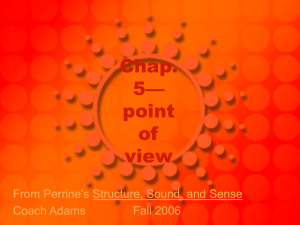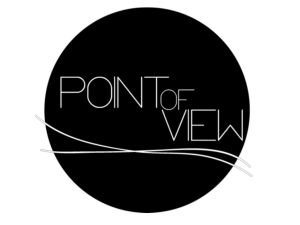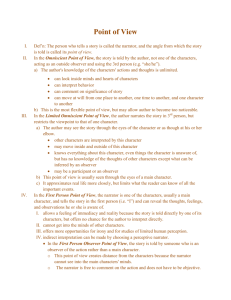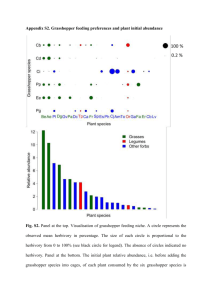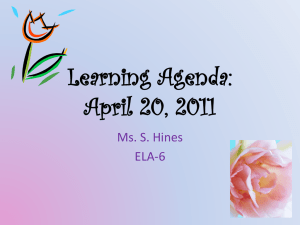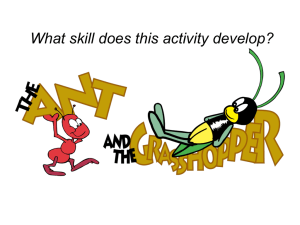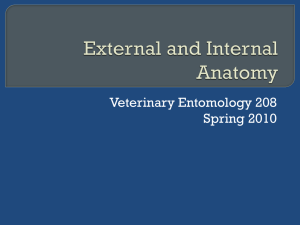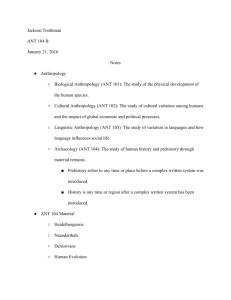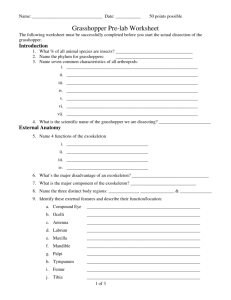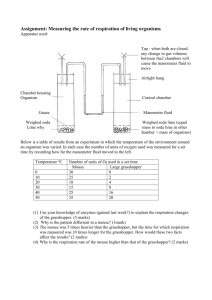LANGUAGE ARTS 9 POINT OF VIEW
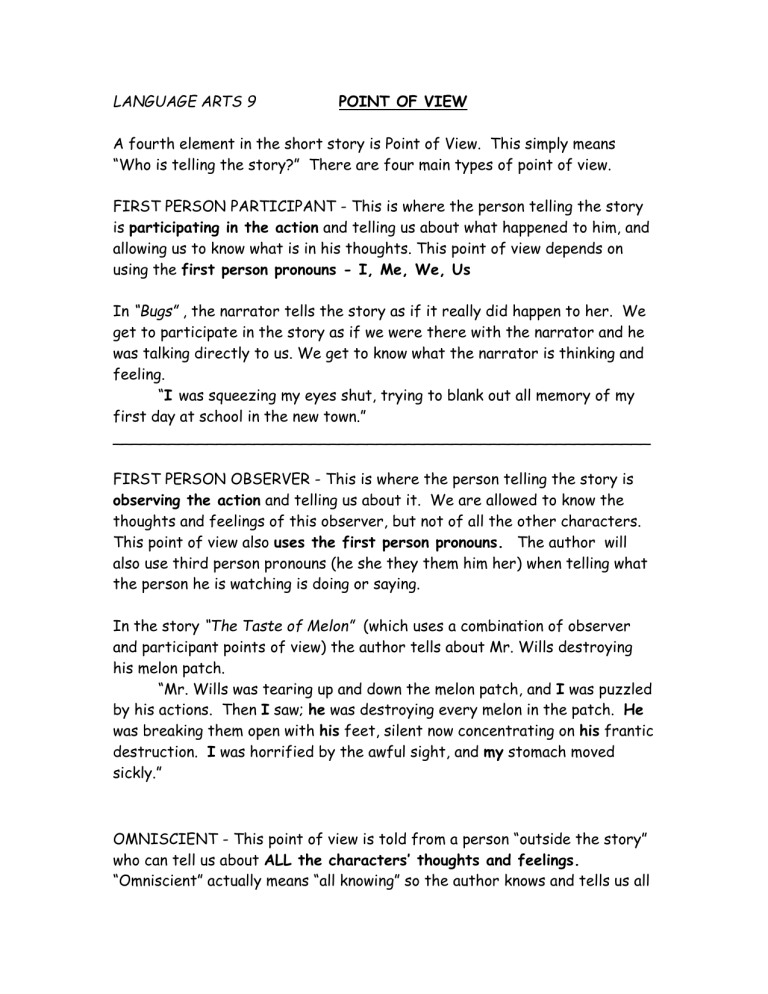
LANGUAGE ARTS 9 POINT OF VIEW
A fourth element in the short story is Point of View. This simply means
“Who is telling the story?” There are four main types of point of view.
FIRST PERSON PARTICIPANT - This is where the person telling the story is participating in the action and telling us about what happened to him, and allowing us to know what is in his thoughts. This point of view depends on using the first person pronouns - I, Me, We, Us
In “Bugs” , the narrator tells the story as if it really did happen to her. We get to participate in the story as if we were there with the narrator and he was talking directly to us. We get to know what the narrator is thinking and feeling.
“I was squeezing my eyes shut, trying to blank out all memory of my first day at school in the new town.”
_________________________________________________________
FIRST PERSON OBSERVER - This is where the person telling the story is
observing the action and telling us about it. We are allowed to know the thoughts and feelings of this observer, but not of all the other characters.
This point of view also uses the first person pronouns. The author will also use third person pronouns (he she they them him her) when telling what the person he is watching is doing or saying.
In the story “The Taste of Melon” (which uses a combination of observer and participant points of view) the author tells about Mr. Wills destroying his melon patch.
“Mr. Wills was tearing up and down the melon patch, and I was puzzled by his actions. Then I saw; he was destroying every melon in the patch. He was breaking them open with his feet, silent now concentrating on his frantic destruction. I was horrified by the awful sight, and my stomach moved sickly.”
OMNISCIENT - This point of view is told from a person “outside the story” who can tell us about ALL the characters’ thoughts and feelings.
“Omniscient” actually means “all knowing” so the author knows and tells us all
about all the characters actions, dialogue, thoughts and feelings. The story is told with third person pronouns. (he, she, they, them, him, her).
In the story “Don’t Make Fun of Old Beliefs” we get to know the thoughts and feelings of all the characters.
“Within minutes the boys were standing on the road opposite the gateway leading up to the decrepit old house. They were vastly relieved to see that no bobbing lights had put in an appearance that night.”. . . . . . . “The boys said nothing. Fish Eggs was right. He was afraid of nothing, of no one.
Their admiration grew as they watched him disappear into the grass that even at this time of year grew tall and rank at the front of the house.”
LIMITED OMNISCIENT - This point of view is the same as omniscient, BUT we only get to know the thoughts and feelings of ONE character. All the other characters’ thoughts and feelings must be told to us by the all knowing narrator. The third person pronouns are also used for the narration of this story.
In the story “The Landlady” there are two characters: Billy and an old landlady. We are told what Billy thinks, but not what the older lady thinks.
“She seemed terribly nice. She looked exactly like the mother of one’s best school-friend welcoming one into the house to stay for the
Christmas holidays. Billy took off his hat and stepped over the threshold.
“Just hand it there,” she said, “and let me help you with your coat.”. . .
. . . ”We have it all to ourselves,” she said, smiling at him over her shoulder as she led the way upstairs. “You see, it isn’t often I have the pleasure of taking a visitor into my little nest.”
“The old girl is slightly dotty”, Billy told himself.
Effectiveness of Point of View
When we read a story written in the first person point of view, (either participant or observer) we feel very close to the main character. It is as if we are a close friend of him, and he is talking directly to us. We feel like he
is a friend and we have been taken into his confidence. It is easy to get involved in stories written in the first person.
However, when this point of view is used, we can only see the situation from that person’s perception, and it is like we are physically tied to the character. We must experience exactly what that character does.
Therefore, we can’t experience what other characters are, and we can’t see how others would feel about the situation.
The omniscient point of view is very good when we need to know the thoughts of all the characters in order to understand the plot. The author can either be inside his characters’ heads, or he can be outside his characters watching them. This can be confusing if the characters have similar names and situations, and if they feel similarly about a situation.
This point of view is widely used by authors.
The limited omniscient point of view has some of the benefits of first person and omniscient. The author can take us into the mind of ONE character and show us what he is thinking and feeling, but he can also be objective and just watch all the other characters. It is like having two points of view in one. This point of view helps unify all the elements of a story because all the events are told from one person’s perspective. It can be difficult, with this point of view, to have all the characters aware of what they need to know without having to create unlikely circumstances.
Manipulating the Point of View.
We can change the point of view in a simple piece of writing and see for ourselves how it changes our perspective
We will rewrite the Aesop Fable provided below by changing only the italicized words in it.
Weary in every limb, the ant tugged over the snow a piece of corn he had stored up last summer. It would taste good at dinner tonight.
A grasshopper, cold and hungry, looked on. Finally, he could bear it
no longer.
“Please, friend ant, may I have a bite of corn?”
“What were you doing all last summer?” asked the ant. He looked the grasshopper up and down. He knew it’s kind.
“I sang from dawn until dark” replied the grasshopper, happily
unaware of what was coming next.
“Well” said the ant, hardly bothering to conceal his contempt, since you sang all summer you can dance all winter.”
This is written in omniscient point of view because we get to see the thoughts and feelings of the ant and the grasshopper
_________________________________________________________
_
Weary in every limb, the ant tugged over the snow a piece of corn he had stored up last summer. It would taste good at dinner tonight.
A grasshopper looked on and said to the ant, “Please, friend ant, may
I have a bite of corn?”
“What were you doing all last summer?” asked the ant. He looked the grasshopper up and down. He knew it’s kind.
“I sang from dawn until dark” replied the grasshopper,
“Well” said the ant, hardly bothering to conceal his contempt, since you sang all summer you can dance all winter.”
This is written in limited omniscient point of view because we get to see the thoughts and feelings of only the ant. We have lost all perspective from the grasshopper, and do not know why he is hungry and how he feels about his situation.
_________________________________________________________
_
Weary in every limb, I tugged a piece of corn I had stored up last summer over the snow. It would taste good at dinner tonight.
It was then I noticed that a grasshopper was watching me. Finally, he said to me, “Please, friend ant, may I have a bite of corn?”
“What were you doing all last summer?” I asked the grasshopper as I looked him up and down. I knew it’s kind.
“I sang from dawn until dark” replied the grasshopper with a smile.
“Well”, I said , hardly bothering to conceal my contempt, since you sang all summer you can dance all winter.”
This is written in the first person participant point of view because the ant is the main character. We see the situation from his perspective, and feel more sympathy for him than for the grasshopper. We do not know why the grasshopper was hungry or how he felt about his situation. Notice the first person pronouns throughout.
_________________________________________________________
_
One day when I was spinning my new web,I overheard an ant tell a grasshopper off. The ant tugged over the snow a piece of corn he must have stored up last summer. He looked like he was anxious to dig into it.
A grasshopper looked on and finally asked “Please, friend ant, may I have a bite of corn?” He seemed to me to be cold and hungry.
“What were you doing all last summer?” asked the ant as he looked the grasshopper up and down with a cold expression.
“I sang from dawn until dark” replied the grasshopper.
“Well” said the ant, “since you sang all summer you can dance all winter.”
The grasshopper looked upset as he hopped away.
This is written in the first person observer point of view because we only get the information about the confrontation from an observer, the spider.
We do not know anything except what he saw, heard, or speculated on. We feel removed from the action because of this.
